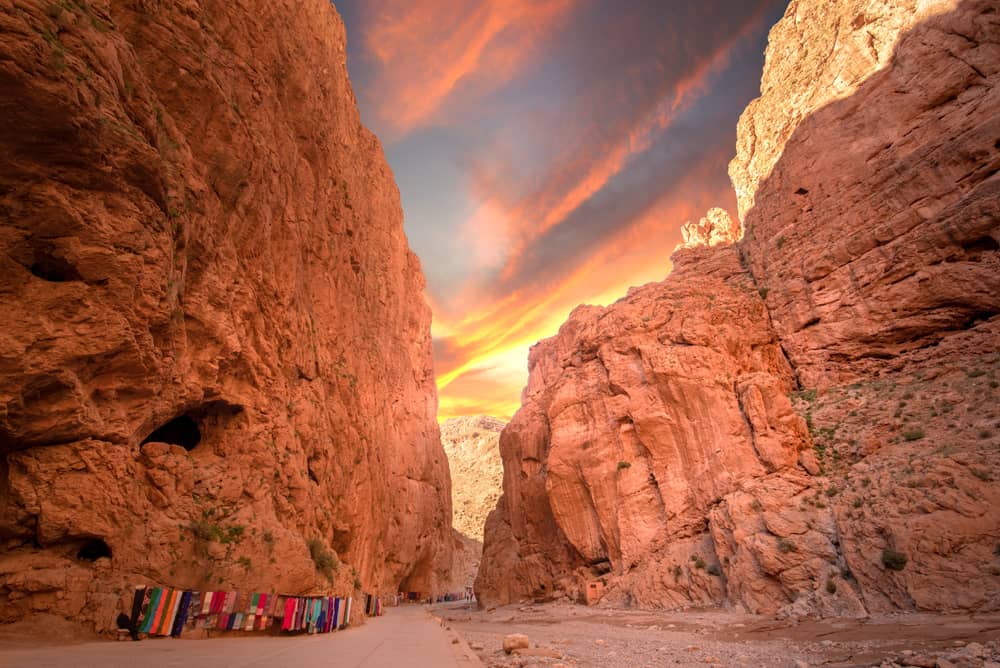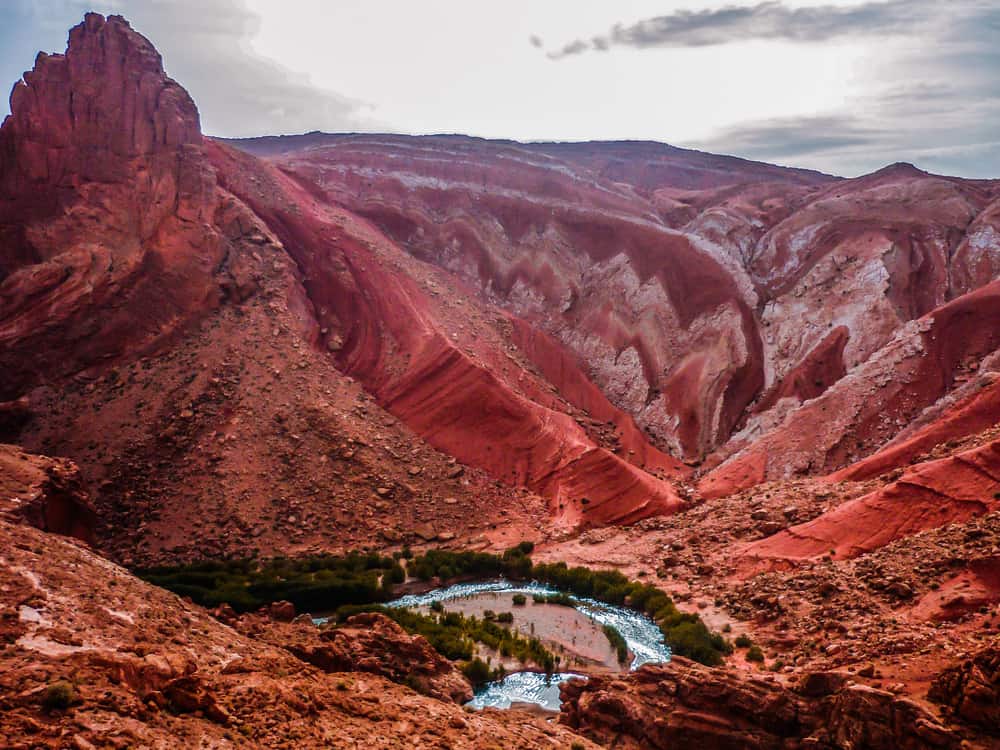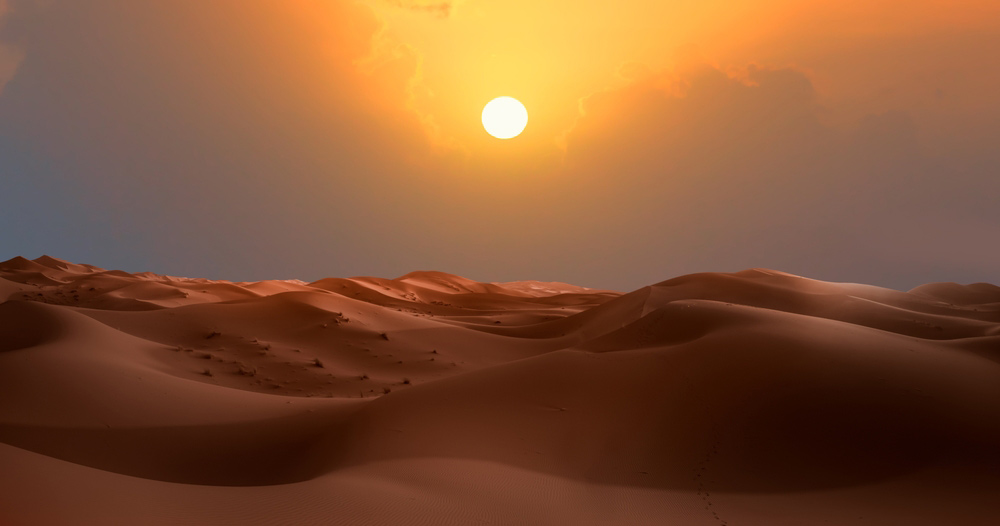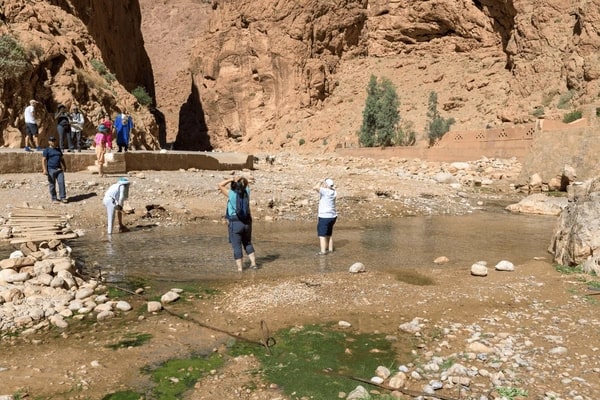Nestled in the High Atlas Mountains of southern Morocco, Todgha Valley and Todgha Gorges are breathtaking natural wonders. Known for their towering red rock cliffs and narrow gorges, these striking formations have been shaped by the winding Todgha River over centuries. The valley is a lush green oasis surrounded by dramatic rock walls, making it a paradise for nature lovers, photographers, and adventure seekers.
The Todgha Gorge is the most famous part of the valley, where cliffs reach heights of nearly 1,000 feet, creating a natural marvel that draws visitors from all over the world. The narrow paths carved by the Todgha River offer a unique landscape for exploration, whether you’re hiking through the valley or simply enjoying the views. It’s a place where the beauty of nature meets the rich culture of the local Berber people.
In addition to its stunning beauty, the valley offers cultural experiences. Visitors can explore Berber villages, learn about traditional Moroccan crafts, and sample delicious local foods like dates and tagines. The blend of scenic landscapes and cultural immersion makes Todgha Valley and Gorges a must-visit destination in Morocco.
Getting to Todgha Valley & Gorges
Todgha Valley is located in the eastern part of the High Atlas Mountains in southern Morocco. To reach it, you can travel from several nearby cities like Marrakesh or Ouarzazate. Getting there requires some planning, but the journey is part of the adventure.
If you’re starting from Marrakesh, you can take a bus or drive. The road trip takes around seven hours, and you’ll pass through scenic areas like the Dades Valley and Skoura Palm Grove. These spots offer great views of date palms, oases, and traditional kasbahs. If you prefer a guided experience, you can book tours that include Todgha Gorge as part of a broader itinerary.
The closest airport is in Ouarzazate, about three hours away by car. From there, you can either rent a vehicle or take a shared taxi to reach Tinghir, the nearest town to the gorges. Another option is to travel from Fes or Errachidia, which are also well-connected by bus routes. Public buses are available, though the ride may take longer. Always check schedules in advance as they can vary.
If you’re not familiar with the region, hiring a local guide is recommended. They can help you navigate the winding roads, especially through the mountain passes. The guides also provide valuable insights into the history and culture of the area, enriching your experience.
Best Places to Visit in Todgha Valley & Gorges

1. Todgha Gorge
The Todgha Gorge is the most iconic attraction in the valley. This stunning natural wonder is known for its towering limestone cliffs that can reach up to 1,000 feet high. The gorge is particularly narrow, with some sections being only 33 feet wide, making it feel like you’re walking through a massive canyon. It’s a favorite spot for hikers and rock climbers alike, offering a unique experience for outdoor enthusiasts. You can spend hours exploring the gorge and walking along the Todgha River that winds through the base of the canyon. Whether you’re a photographer, adventurer, or simply someone who loves nature, the breathtaking beauty of Todgha Gorge makes it a must-visit.
For rock climbers, Todgha Gorge is world-famous for its challenging routes. With over 400 climbing routes available, it attracts climbers from all over the globe. Local climbing schools offer lessons and equipment rentals for those who are interested in trying it out. The gorge is perfect for both beginners and experienced climbers, making it a versatile spot for this extreme sport.
2. Tinghir
The town of Tinghir lies just outside the entrance to Todgha Gorge and is the gateway to the valley. A visit to Tinghir is an essential part of exploring the Todgha Valley. This charming town is known for its Todra Palmeraie, a vast oasis filled with date palms and lush greenery. The oasis offers a sharp contrast to the surrounding rocky desert landscape. A walk through the Palmeraie is like stepping into a hidden paradise, with shaded paths, small streams, and traditional irrigation systems that date back centuries.
Tinghir is also famous for its Berber culture. Visitors can explore traditional Berber villages nearby, where the locals speak Tamazight and continue to practice age-old customs. In Tinghir, you’ll find artisans selling Moroccan carpets, handmade crafts, and delicious local foods like dates and tagine. The town’s weekly market is a lively affair where locals gather to trade goods and socialize, offering travelers a glimpse into everyday life in this region.
3. Todra Palmeraie
The Todra Palmeraie is an expansive oasis located near Tinghir. It’s one of the most beautiful oases in southern Morocco, filled with thousands of date palms, fruit trees, and small farms. This green oasis stretches along the Todra River, offering visitors a chance to escape the heat and relax in the shade of the palm trees. The locals have cultivated the land here for centuries, and traditional farming methods are still in use today. Walking through the palmeraie is a peaceful experience, as you can see local farmers tending to their crops or herding sheep.
In addition to its natural beauty, the Palmeraie is home to several small Berber villages. These villages are an excellent place to learn about traditional Berber culture, from their architecture to their crafts. You can visit these villages on foot or by bike, making it a great day trip for those looking to explore the area beyond the gorge itself.
4. Berber Villages around Todgha Valley
The Berber villages around Todgha Valley are an important part of the region’s cultural heritage. Villages like Tizgui and Ait Baha offer a glimpse into the daily lives of the Berber people, who have lived in this region for centuries. These villages are known for their traditional mud-brick houses and terraced fields that line the steep slopes of the valley. A visit to these villages gives you the chance to interact with the locals, sample traditional Berber food, and even purchase handmade goods like woven carpets and pottery.
One of the best ways to explore these villages is through a guided tour, as local guides can explain the history, customs, and traditions of the Berber people. Many of the guides speak Tamazight, the local Berber language, but also understand Arabic and French, which helps bridge the communication gap. A visit to these villages also often includes a stop at one of the many kasbahs (fortified homes), which are important landmarks in Berber architecture.

5. Dades Valley and Dades Gorge
While Todgha Valley is famous for its gorges, it’s worth taking the time to explore the nearby Dades Valley and Dades Gorge. Located just a short drive from Todgha, the Dades Valley is known for its dramatic rock formations and winding roads. The Dades Gorge offers another opportunity for hiking and rock climbing, with trails that offer spectacular views of the Atlas Mountains and the valley below. One of the highlights of the Dades Gorge is the unique rock formation known as the Monkey Fingers, a series of strange, rounded rocks that resemble a monkey’s paw.
The Dades Valley is also home to ancient kasbahs and small villages where traditional life continues unchanged for centuries. This area is rich in history and culture, making it a perfect day trip for travelers staying in Todgha Valley. The winding road through the Dades Gorge is famous for its hairpin turns and stunning scenery, making it one of the most picturesque drives in all of Morocco.
6. Skoura Oasis
On your way to or from Todgha Valley, make sure to visit the Skoura Oasis. This lush oasis is located between Ouarzazate and Todgha, and it’s known for its vast palm groves and historic kasbahs. The most famous of these is the Kasbah Amridil, a beautifully preserved example of Berber architecture that dates back to the 17th century. The Skoura Oasis is an excellent spot for photography enthusiasts, offering a mix of natural beauty and historical landmarks. It’s also a great place to take a break from the heat and enjoy the tranquility of the palm groves.
Skoura is known for its agriculture, particularly the cultivation of dates. The palm trees here are not only a vital source of food for the local population but also provide materials for making baskets and other handicrafts. A visit to the Skoura Palm Grove is a peaceful way to end your journey through southern Morocco.

7. Sahara Desert Excursions
While not located within Todgha Valley itself, the Sahara Desert is a popular extension to any visit to the region. The Erg Chebbi dunes near Merzouga are some of the most impressive in Morocco, offering endless stretches of sand and breathtaking desert landscapes. Many visitors choose to spend a night in the desert, staying in traditional Berber tents. These camps provide a unique experience where you can enjoy the starry sky, listen to traditional music, and even try sandboarding down the dunes.
Camel treks through the Sahara are another highlight. These tours allow you to explore the desert just as the nomadic Berber tribes have done for centuries. If you have time, a visit to the Sahara is an unforgettable addition to your trip to Todgha Valley & Gorges.
When to Visit Todgha Valley & Gorges
Timing your visit to Todgha Valley is important. The best times to go are during spring (March to May) and autumn (September to November). In these months, the weather is mild and perfect for outdoor activities like hiking and exploring. The hot desert climate means that summer can be scorching, with temperatures rising above 40°C (104°F), making it less ideal for walking and climbing. Winter can be chilly, especially at night, though the days are usually pleasant.
If you’re interested in local culture, visiting a weekly market in the nearby towns is a great idea. These markets are full of life, with Berber crafts, Moroccan carpets, and delicious foods like dates being sold. You may also want to plan your visit around festivals in the region. For example, the Moussem des Roses in the Dades Valley celebrates the harvest of rose petals each spring and is a colorful event not to be missed.
What to Do in Todgha Valley & Gorges

Todgha Gorge is famous for outdoor activities. Hiking is one of the most popular things to do. There are several trails through the valley and the gorge. Some are easy, and others are more challenging. No matter your skill level, you’ll enjoy stunning views of the red rock walls, the Todgha River, and the surrounding palm groves. The paths lead you through the towering cliffs and along the riverbanks, making it an unforgettable experience.
If you love climbing, the gorges are a perfect place to visit. The towering cliffs have become a world-class destination for rock climbers. Whether you’re a beginner or an experienced climber, some routes suit all skill levels. You can find guided climbs available from local experts, who can also provide equipment.
Exploring the Berber villages nearby is another highlight. Visit Tinghir or smaller villages like Tizgui to learn about the Tamazight-speaking locals and their traditions. The people here are known for their hospitality and many offer tours where you can learn about their daily lives, farming, and crafts like weaving. Don’t forget to try the traditional tagines and locally grown dates, a staple food in the region.
For those looking for a quieter activity, taking a walk along the Todgha River is calming. The river provides a contrast to the rocky cliffs, with its cool waters flowing through the valley. You can stop for a picnic or simply enjoy the natural surroundings.
Explore Around Todgha Valley
Todgha Valley isn’t the only attraction in this area of southern Morocco. Nearby is the equally stunning Dades Gorge, another breathtaking valley carved out by the Dades River. The gorge is known for its unique rock formations, also called the Monkey Fingers, due to their strange shapes. Hiking or driving through the Dades Valley offers amazing views of date palm groves, small oases, and old kasbahs.
You can also explore the town of Skoura, located between Ouarzazate and Todgha Valley. Skoura is famous for its green oasis and well-preserved kasbahs, like the Kasbah Amridil, which has been featured in many films. It’s a peaceful place to explore and take pictures.
For a different experience, consider a desert excursion to the Sahara Desert. The Erg Chebbi dunes, located near Merzouga, are some of the largest in Morocco. Visitors can ride camels, spend the night in desert camps, and even try sandboarding. This adventure offers a complete change of scenery from the rugged mountains and gorges of Todgha.
Where to Stay in Todgha Valley & Gorges
There are plenty of accommodation options for travelers visiting Todgha Valley. For those who prefer comfort, there are guesthouses and hotels in nearby towns like Tinghir. These range from basic rooms to luxury stays, offering amenities like Wi-Fi and meals. Some popular options include Kasbah Hotel Essalam and Auberge le Festival, which is located in the valley itself and offers panoramic views of the gorges.
If you want a more adventurous stay, there are several camping sites available. Many tourists choose to camp along the Todgha River or closer to the gorge. It’s a great way to connect with nature and enjoy the peace of the valley. Eco-lodges are also becoming more common, giving environmentally-conscious travelers a chance to stay in places that respect the local ecosystem.
Practical Travel Tips for Todgha Valley
When planning your trip to Todgha Valley, it’s essential to pack appropriately. If you’re visiting in the summer, be sure to bring plenty of water, sunscreen, and a hat, as the sun can be intense. In the cooler months, a jacket is necessary, especially for the evenings when temperatures drop. Comfortable shoes are a must, particularly if you plan to hike or explore the valley on foot.
Hiring a local guide is highly recommended. They can offer insider knowledge of the trails and help you get the most out of your visit. They also help bridge the language gap, as many locals in the Berber villages speak Tamazight rather than Arabic or French.
Finally, always respect local customs and traditions. The people in this region are known for their hospitality, but it’s important to be mindful of cultural differences. Dressing modestly and asking for permission before taking photos of people are simple ways to show respect.
Conclusion
Todgha Valley & Gorges is a place where natural beauty meets cultural heritage. From its towering cliffs and stunning hikes to the warm hospitality of the Berber people, it’s a destination that offers something for every traveler. Whether you’re seeking adventure, relaxation, or a mix of both, this unique valley in the High Atlas will leave you with lasting memories.
FAQs
Is there an entrance fee to visit Todgha Gorge?
No, there is no entrance fee to visit Todgha Gorge. It is free and open to the public.
How long should I plan to stay in Todgha Valley?
A 1-2 day stay is usually enough to explore the gorge, hike, and visit nearby attractions, but longer stays allow for more in-depth exploration.
Can I visit Todgha Valley on a day trip from Marrakesh?
While possible, a day trip from Marrakesh is not recommended due to the long travel time (around 7 hours one way). It’s better to plan for an overnight stay.
Is there cell phone service in Todgha Gorge?
Cell phone service is available in the nearby towns, but coverage may be limited or spotty inside the gorge itself.
Are there any restaurants in Todgha Valley?
Yes, there are small restaurants and cafes in Tinghir and along the way to the gorge, offering local dishes like tagine and couscous.
